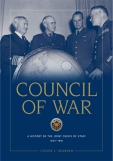 Стивен Л. Риэрден
Стивен Л. Риэрден
Военный совет
История Объединенного комитета начальников штабов
1942-1991
The history of the Joint Chief of Staff parallels the emergence of the United States in a great-power role and the growing demands that those responsibilities placed on American policymakers and military planners. During World War II, the major challenge was to wage a global war successfully on two fronts, one in Europe, the other in Asia and the Pacific. Afterwards, with the coming of an uneasy peace, the JCS faced new, less well-defined dangers arising from the turbulent relationship between east and West known as the Cold War. The product of long-festering political, economic, and ideological antagonisms, the Cold War also saw the proliferation of nuclear weapons and soon became an intense and expensive military competition between the United States and the Soviet Union. Though the threat of nuclear war predominated, the continuing existence of large conventional forces on both sides heightened the sense of urgency and further fueled doomsday speculation that the next world war could be the last. A period of recurring crises and tensions, the Cold War finally played out in the late 1980s and early 1990s, not with the cataclysmic confrontation that some people expected, but with the gradual reconciliation of key differences between east and West and eventually the collapse of Communism in Europe and the implosion of the Soviet Union… From Preface